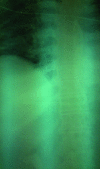Role of Ultrasonography in Detecting the Localisation of the Nasoenteric Tube
- PMID: 28439443
- PMCID: PMC5396894
- DOI: 10.5152/TJAR.2017.80269
Role of Ultrasonography in Detecting the Localisation of the Nasoenteric Tube
Abstract
Objective: In this study, we aimed to determine the success rate of nasoenteric tube (NET) insertion into the postpyloric area using ultrasonography (USG) and compare with the commonly used method direct abdominal graphy.
Methods: A single anaesthesiologist placed all the NETs. The NET was visualised by two radiologists simultaneously using USG. The localisation of the tube was confirmed using an abdominal graph in all patients.
Results: The blind bedside method was used for NET insertion into 34 patients. Eleven of the tubes were detected passing through the postpyloric area using USG. In one case, the NET could not be visualised in the postpyloric area using USG; however, it was detected in the postpyloric area through control abdominal radiography. In 22 patients, NETs were detected in the stomach using control abdominal radiography. The rate of imaging post pyloric using USG was 91.6%. When all cases were considered, catheter localisation was detected accurately using USG by 97% (33 in 34 patients).
Conclusion: USG is a reliable and practical alternative to radiography, which can be used to detect localisation of the nasogastric tube and NET.
Keywords: Nasoenteric tube; aspiration; enteral feeding; radiography; ultrasonography.
Conflict of interest statement
Conflict of Interest: No conflict of interest was declared by the authors.
Figures
References
-
- Marik PE, Zaloga GP. Early enteral nutrition in acutely ill patients: a systematic review. Crit Care Med. 2001;29:1495–501. - PubMed
-
- Kreymann KG, Berger MM, Deutz NEP, Hiesmayr M, Jolliet P, Kazandjiev G, et al. ESPEN Guidelines on Enteral Nutrition:Intensive care. Clin Nutr. 2006;25:210–23. https://doi.org/10.1016/j.clnu.2006.01.021. - DOI - PubMed
-
- Bankhead R, Boullata J, Brantley S, Corkins M, Guanter P, Krenitsky J, et al. ASPEN Board of directors. Enteral Nutrition Practice Recommendations. J Parenter Enteral Nutr. 2009;33:122–67. https://doi.org/10.1177/0148607108330314. - DOI - PubMed
-
- Kabaçam G, Özden A. Enteral Tüple Beslenme. Güncel Gastroenteroloji. 2009;13:201–10.
LinkOut - more resources
Full Text Sources
Other Literature Sources



